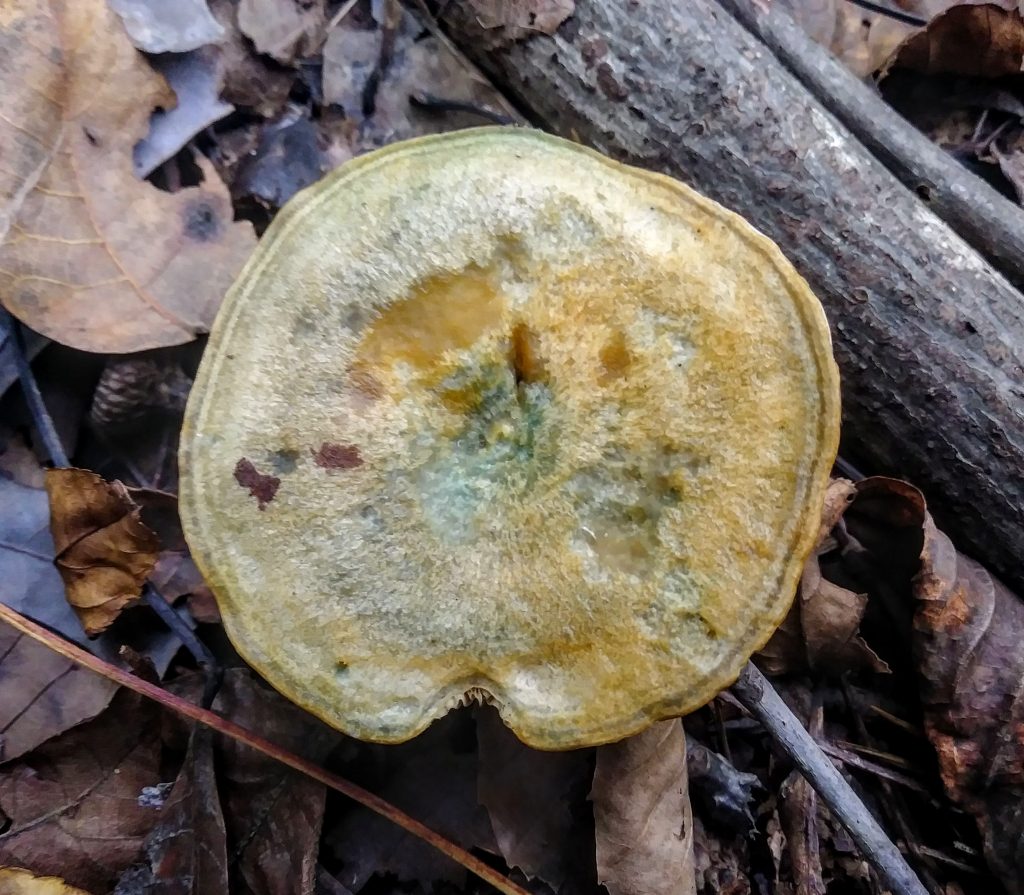In the Fall of 2018, I realized that photographs of mushrooms weren’t good enough. With the help of the print-making professor, we designed an independent study to log mushroom species of the Guilford woods. Within my first month, I had already identified nearly forty distinct species of mushrooms, lichens, and slime molds. As opposed to spring-fruiting mushrooms, these fall species have significantly less time above ground and are dependent on rainfall and humidity. Below is a list of common names and scientific names of different species found within the single month of September.

- Jellied False Coral or Tremellodendron pallidum
- Lilac Bolete or Boletus separans (grows near oak)
- Firesite Funnel or Faeberia carbonaria (grows on burnt wood)
- Ornate Bolete or Retiboletus ornatipes (grows near hardwoods)
- Dog Stinkhorn or Mutinus elegans
- Cinnabar Red Chanterelle or Cantharellus cinnabarinus
- Oyster or Pleurotus ostreatus (grows on hardwood)
- Puffball or Lycoperdon curtisii
- Hygrophorous Milky or Lactarius hygrophoroides (grows near oaks)
- Quilted Green Russula or Russula parvovirescens
- Golden Spindles or Clavulinopsis fusiformis
- Carnival Candy Slime Mold or Arcyria denudata
- Coker’s Amanita or Amanita cokeri
- Shining Waxcap or Gloioxanthomyces nitida
- Black-Footed Marasmius or Tetrapyrgos nigripes (growing on black walnut)
- Indigo Milk Cap or Lactarius indigo
- Bleeding Bonnet or Mycena sanguinolenta
- Violet Gray Bolete or Tylopilus plumbeoviolaceus
- Cobalt Crust Fungus or Terana caerulea
- Red Pinwheel or Marasmius plicatulus
- Gemmed/Jewelled Amanita or Amanita gemmata
- Inky Cap or Coprinopsis atramentaria
- Dog Vomit Slime Mold or Fuligo septica
- Silver Leaf Fungus or Chondrostereum purpureum
- Beefsteak Fungus or Fistulina hepatica
- Fairy Fingers or Clavaria vermicularis
- Old Man of the Woods or Strobilomyces strobilaceus

Every shade of the rainbow was represented from the leaky red Bleeding Bonnet all the way to the deep purples in the Violet Gray Bolete. The majority of these species are dependent on tree species and some will only grow on certain kinds of wood (Firesite Funnels only grow on burnt wood and Boletes and Milkcaps tend to grow near and around hardwoods only). Through documentation, patterns began appearing, with large populations found in the Highlands and Rope Treeland (to the left/West of the creek) during this time of year. I began to notice how the sense of smell could help me locate and identify certain species (the only reason I found the Dog Stinkhorn was by getting a whiff of its putrid aroma). Though some are simply too small to eat, about 15 or more of the listed species are considered edible, with only 2 or 3 being certainly poisonous (definitely Coker’s Amanita and the Gemmed Amanita). One of the most interesting species was an abundant one, the Inky Caps, are edible with caution. They contain a toxin that interferes with the body’s ability to metabolize alcohol, so it is advised to not drink alcohol for up to 5 days after consumption. **NO MUSHROOMS WERE CONSUMED DURING THE DOCUMENTATION PROCESS** (EVERY MUSHROOM SHOULD BE TREATED AS POISONOUS UNTIL PROPERLY IDENTIFIED)